Doing your bit for the environment not only makes you feel good, but in many cases it can actually save you money too! This Mother Earth Day, we’ve been thinking about the best ways to make your Italian home more eco-friendly.
As you proudly stand outside your dream property and look at your land, you will suddenly realise that you now have the privilege and responsibility to protect and care for not only your plot, but also the planet and all the life that it supports. It’s an important thing to keep in mind when renovating and making improvements to your Italian house.
Eco-friendly home renovations cost money initially, but will no doubt save you money on heating and future maintenance. Plus, the Italian government have many bonus schemes to help you pay for it. Sounds like a win-win to us!
Have questions about buying in Italy? Our partner, Your Overseas Home, is hosting a series of webinars where you can hear from property experts, lawyers and more, all from the comfort of your sofa. Register your interest today.
First of all, what is Mother Earth Day?
In 2009, the United Nations designated April 22 as International Mother Earth Day. Various events each year help to promote harmony with nature and the Earth to achieve a balance between the economic, social and environmental needs of present and future generations. Millions of people from 192 countries around the world unite to celebrate the Earth and to promote its conservation.
13 steps to make your Italian home more eco-friendly:
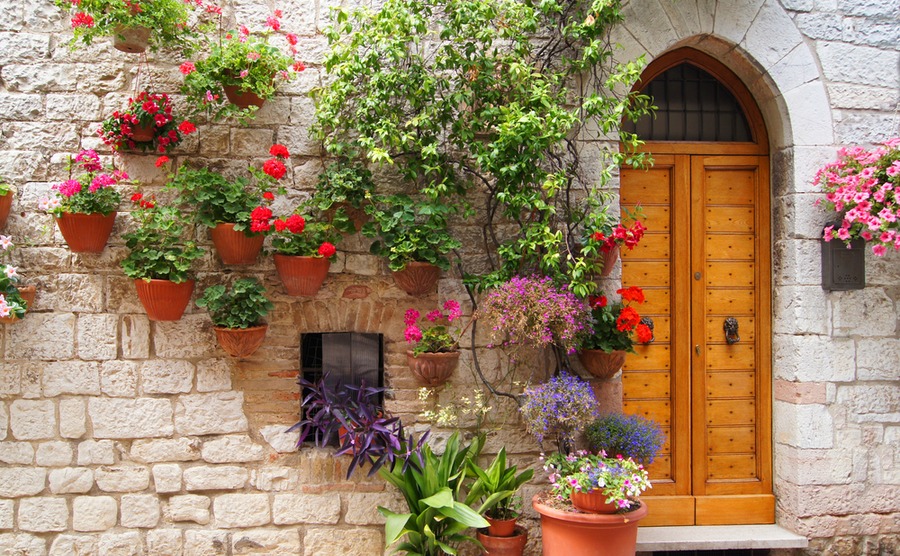
Eco- friendly home improvements can save you money on heating and future maintenance.
1. Choose an energy-efficient property
Estate agents should be able to tell you the energy rating of the properties they are advertising. Each building is assigned an energy efficiency class ranging from A4 (the most efficient) A3, A2, A1, B, C, D, E, F, to G (the least efficient). The buildings energy consumption is indicated by a number. Expressed in kWh/m2 per year it indicates the kilo-wattage of energy needed to heat the space per year. The less energy used the more eco-friendly it is likely to be.
Energy Performance certificate
In Italy it is mandatory to provide an energy performance certificate (Attestato di Prestazione Energetica APE) with every property for sale. The APE certificate will be attached to the sales agreement. The document should also provide potential buyers with an energy consumption rating and recommendations for improvements.
An APE is also necessary when trying to claim a tax deduction or eco-bonus when carrying out renovation work. However, buildings under 50m2, ruins, non-residential farm buildings and uncompleted houses might not have a rating.
Who issues the APE?
An accredited and qualified engineer, architect or surveyor does the inspection. This “certificatore energetico” must have the specific skills in the field of energy efficiency applied to buildings. Using certified software to evaluate the energy efficiency, they inspect doors, walls, windows, existing cooling and heating systems, renewable energy production systems and hot water production.
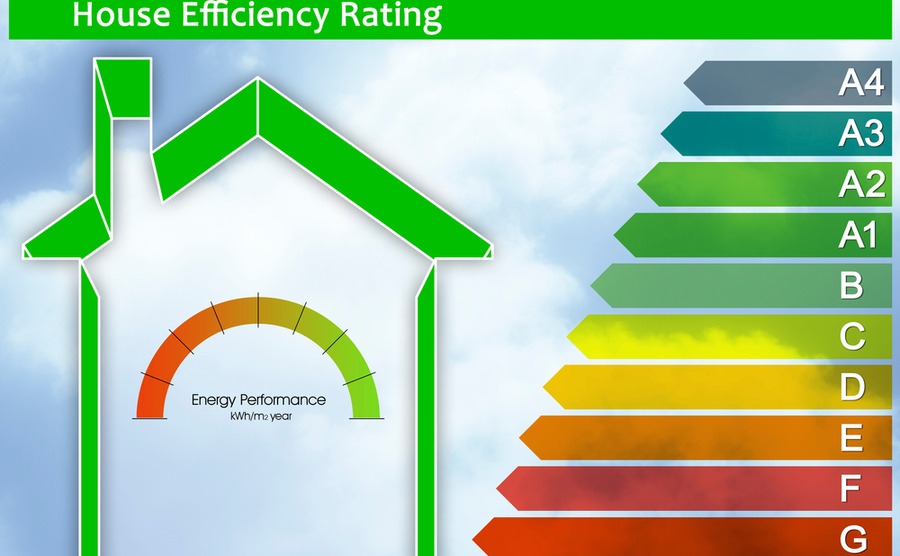
Each building is assigned an energy efficiency class – A4 (most efficient) G (least efficient)
2. Know what questions to ask on your viewing trip
When viewing property you should ask questions like: How is the property heated and what does it cost the current owners? Are windows and doors double glazed and well-sealed? How is hot and cold water supplied to the property? Is there any insulation? Which sides of the property get the sun?
Thinking about going on a viewing trip to Italy? Make sure you know exactly what to ask the estate agent. Get your free Italian Viewing Trip Guide today.
3. Beware of Mother Nature
Research potential land problems in the area, so that Mother Nature doesn’t have any surprises for you down the line. When viewing a property, try and imagine how heavy rain will flow around the property and on access roads. Then, protective measures can then be put in place during renovation.
At the early stages of researching an area, try typing in the name of the town or province and words such as flooding, landslide, earthquake, factories, pollution. If there have ever been any problems, news stories will pop up. Just be aware that news journalists can exaggerate, so don’t let it put you off viewing a property.
4. Use local materials for home improvements
When doing improvements to your home you should consider where you are going to source materials. Delivery lorries are big polluters, so think twice before ordering materials from abroad. Try and buy locally where ever possible and ask where the materials come from.
5. They say the best (and most eco-friendly!) things come in small packages
The smaller the house the less material will be needed for any improvements you want to do. A smaller house also uses less energy and is more eco-friendly. Heating and air-conditioning use a lot of energy and can be expensive to run. If you have many rooms, consider heating just those you are using. It’s also better to buy a house the size you need, rather than doing costly extensions.
You may dream of living in a large villa or castle, but consider how much it will take to heat those large rooms with high ceilings. The idea of downsizing can be difficult for many people to contemplate. However, it is worth thinking about how much of your current home you actually use. No one likes paying bills, so if you can buy a property that is more energy efficient and costs you less to run, it’s win-win for you and Mother Earth.
6. Take advantage of natural light and heat
When looking at properties, take note of where the sun rises and sets. In northern regions and in the mountains, you will want your home to benefit from free heating from the sun through windows. Note also the position of mountains and trees that may block the sun when it’s low. If you plan to have solar panels, think about suitable places they could be positioned to make the most of the solar energy.
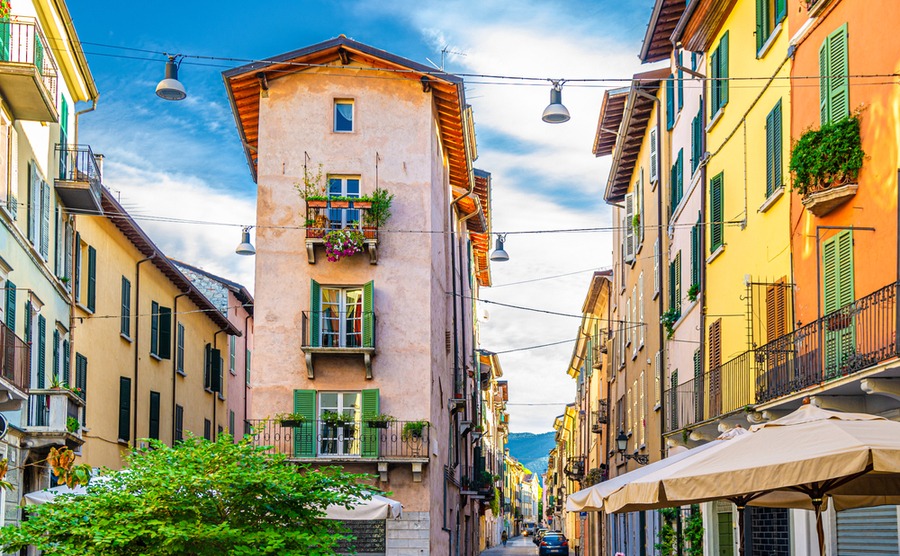
Shutters will help to keep the heat out and reduce the need for air conditioning
In the south, you may be more concerned about keeping your home cool. Shutters and verandas will help keep the heat out and reduce the need for air-conditioning. The positioning of windows and doors should allow a through breeze at night, or a cool air ventilation system could be installed. Basement rooms are a cool place to retreat to for a siesta in the afternoon and a shaded pool is more refreshing than one in the sun.
7. Stop the drafts
One of the best ways to preserve energy is to have good insulation and a good seal around doors and windows. This isn’t always easy to do in old houses, while still keeping the beautiful old doors and windows. However, I wouldn’t rush to replace solid wood with plastic. Curtains, shutters and double glazing installed on existing windows can make a big difference. Remember that winters in Italy may be shorter than you are used to, so for the greater part of the year you will be trying to keep the heat out, not in.
Insulating walls
House builders of the past really knew how to build homes using local materials. The thick stone walls keeping out the heat in summer and holding it inside in winter. Thick stone walls, wooden beams, rugs on the floor and a wood burning stove are a great combination, to feel cosy in the winter.
Many newer villas were designed for summer use, and only have single walls. To use them all year round it may be necessary to insulate the walls. Mostly, insulation panels are used on the outside of walls. When used on an existing building, it is essential to verify the feasibility of the intervention, both technically and in terms of permits. For example, historic buildings may have restrictions and wall surfaces might not be flat enough to attach the panels.
In some circumstances, internal thermal panels can be used or if there is a double wall, insulation can go between them. You can also buy thermal insulating plaster; however, this is not as effective as a thick thermal coat.
Remember that winters in Italy may be shorter than you are used to, so for the greater part of the year you will be trying to keep the heat out, not in.
Insulating roofs
Roof insulation can be classified as synthetic (such as polyurethane or polystyrene) , mineral (such as rock wool) and organic (such as cork, wood fibre, hemp, sheep wool etc.). Organic insulation is most desirable in eco-friendly homes. They have a higher purchase cost, but excellent properties, and a low environmental impact. Although you should be careful about the toxicity of glues and binders used to hold them in place.
8. Reduce, reuse, recycle
Instead of sending all your renovation waste to the landfill, try and salvage some and find a use for it. Old timbers and metalwork can be used to make unique pieces of furniture. Roof tiles can be cleaned up and reused. Stone could come in handy for garden paving and walling. Even small pieces of stone, glass and tiles can be turned into beautiful mosaics. Sort out any other card, glass, plastic, rubble, old oil, and appliances and take it to the nearest recycling centre.
Before buying new, see if there is something you can re-purpose. There are some fantastic reclamation centres and antique and bric-a-brac markets where you can find interesting things. Be inspired and use your imagination. Scrap metal yards buy metal and also put some things to one side if they think they can sell it for more than its weight value. It’s worth seeing what old gates, railings, scaffolding etc. they have before buying new.
9. Decorate using eco-friendly paint
It is the VOCs (volatile organic compounds) in some paints, glues and varnishes that you should try and avoid. Nowadays, you can buy more eco-friendly varnishes and paints. Ask for “Vernici e pitture ecologiche”, a true whitewash (also called lime wash) and all-natural paint made from lime mixed with water. It’s antimicrobial, environmentally friendly, versatile and cheap!
For innovative ideas on raising the money to buy your Italian home, read How to Pay for an Italian Property.
10. Look at energy labels on appliances
In Italy, energy labels, are a big consideration when buying kitchen and laundry appliances. From 1 March 2021, a new EU energy classification has been introduced on the labels of dishwashers, washing machines, refrigerators and TVs, and from 1 September, light bulbs too. By 2023, it will be extended to other commonly used electronic products. In the future there will also be a “repairability” index. This should encourage manufacturers to build eco-friendly appliances to last, and have spare parts easily available for repairs.
During transition, there is going to be some confusion, as a refrigerator that before had an A +++ label could now fall into category C. At first, no appliance will fall into category A and only a few will have the B and C label, in order to encourage the invention and development of new, more energy efficient products. The new labels can be identified by the New QR code at the top, which gives access to more information on the model.
11. Water conservation
Italians have long been aware of the need to preserve water; the ancient Romans were building water systems centuries ago. Many old Italian buildings were designed to collect water from the roof and store it in underground cisterns. You can also save water by using low flow toilets and taking showers instead of baths.
You can save water by using low flow toilets and taking showers instead of baths
Today, countryside homes are more likely to have their own artesian well or have water delivered and pumped into a water tank. However, rain water and grey water can still be collected for watering plants. Purification and water filtration systems have also improved over the years.
12. Consider installing solar panels
When working out your budget for a house purchase, consider the cost of installing a solar panel system as soon as the property is yours so you generate electricity using natural solar power.
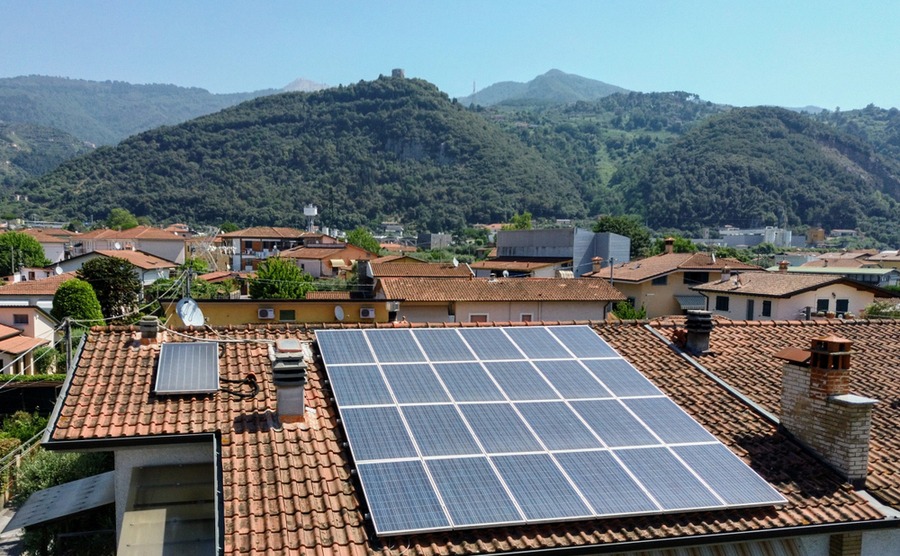
Aerial view of a house with photovoltaic and solar thermal panels
Photovoltaic solar panels
If you install photovoltaic panels (Fotovoltaico) that produce electricity, this will have a knock-on effect on all the heating and appliances you buy. More importantly, it should be done at the same time as other electrical work.
The perfect combination is photovoltaic panels and a new heating pump. This is something being encouraged by the government and there is a 110% eco-bonus on offer, that could cover all your costs as part of other improvements. The minimum a small house will need is 3.5 kw, but if you use a lot of electrical appliances, 5 kw is more realistic.
Enel is the biggest electricity provider in Italy. They also do deals on photovoltaic solar panels that are connected to the grid. Prices generally work out around €1,000 per kilowatt, but it’s definitely worth comparing prices with other specialist companies.
Hot water solar panels
Another great option, that saves you money on heating hot water (aqua caldo) for showers and taps, are solar thermal panels. Two panels with a water tank, costs around €1,200. With all the sun we get in Italy, these are very popular and can be bought through your local plumbing supply store. If you are installing new plumbing as part of your renovation work, make sure it is planned out to receive hot water from a solar panel from the start. You don’t want to have to get the plumbers back, making a mess drilling floors and walls to put in new pipework, after you have decorated!
Moving to a new country is a big deal and can be daunting. Our handy Emigration Guide covers everything you need to know about moving abroad, including some top tips for settling in.
12. Stick to growing native plants in your garden
So much water and energy is lost when people try to grow plants that wouldn’t normally grow in that region. Take a look around at what grows well on neighbouring land and plant native species of plants that don’t require excessive amounts of watering to survive in the local climate.
Consider growing more edible plants such as vegetables, herbs and fruit. One of the great pleasures of Italian gardens is being able to pick fresh herbs from outside your kitchen door. Many countryside houses will already have olive, fruit and nut trees. You can’t get fresher than that, and they don’t come in plastic bags!
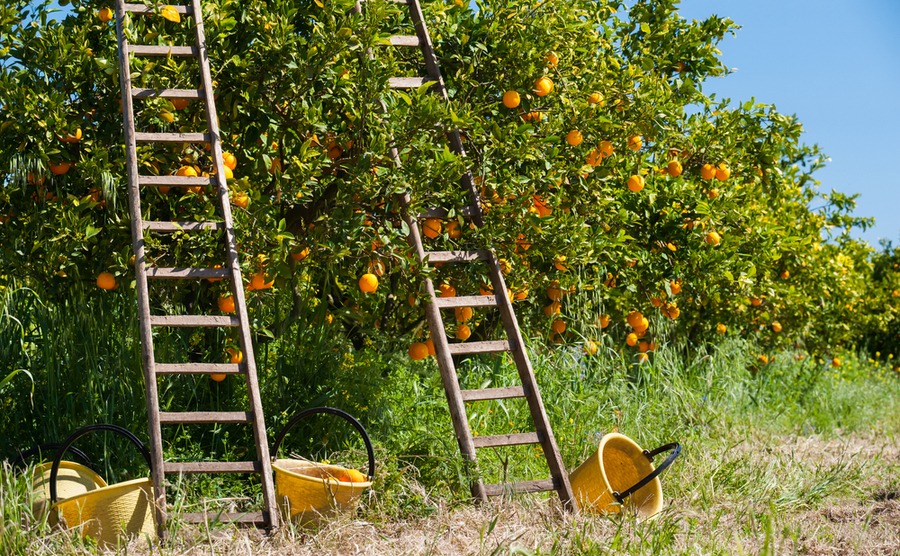
Stick to growing native plants in your garden
Remember also to leave places for indigenous plants and places for nature to live and nest. Wild flowers will attract butterflies, bees and other pollinators that are so vital to the eco-system. Leave some gaps in the stonework for geckos, and ledges for bird nests. Enjoy looking at the natural world around you. It feels such a privilege when the same pair of hoopoe birds choose to visit each year, or hedgehogs, or toads.
13. Drive electric
At the same time as installing new electrics in your property, you could also put in place the infrastructure for charging an electric car. With electric cars being the future of eco-friendly transportation, the first car you buy when moving to Italy is likely to be just that. Italian car maker Fiat have a range of electric cars starting at €19,900, with big discounts on trade-ins. The government is also offering an eco-bonus incentive.
Government incentives
The Italian government are encouraging house owners to upgrade the energy class of their home. For improvements that increase the energy class, there are schemes that offer up to 110% eco-bonus. It’s been reported that many of the renovation bonuses will be set at 75% and that the expiry date is to be extended.
For home improvements that increase the energy class, there are government schemes that offer up to 110% eco-bonus
Changes are about to be made to the bonuses on offer to allow more people access to the scheme. This should also benefit people upgrading farms, hotels, small businesses or an agriturismo, as well as private homes. Always seek professional advice to see what you might be entitled to before starting home improvements – it could save you thousands.
The types of work included in the various bonus schemes include thermal wall insulation, replacement of the winter heating system, a photovoltaic solar system, infrastructure for electric vehicles, replacement of windows and shutters, restoring facades, and measures to improve the strength of your property against seismic risk. See how to improve your Italian home and get a tax rebate here.
Explore the UNESCO Geoparks in Italy
UNESCO encourages combining conservation with sustainable development, while also involving local communities. They have designated 119 UNESCO Geoparks across 33 countries that have landscapes of special geological significance, which are now managed and protected, while inviting visitors and the local community to enjoy and preserve them. Nine of these Geoparks are in Italy, so get out there, explore and experience the very best of Italian nature.
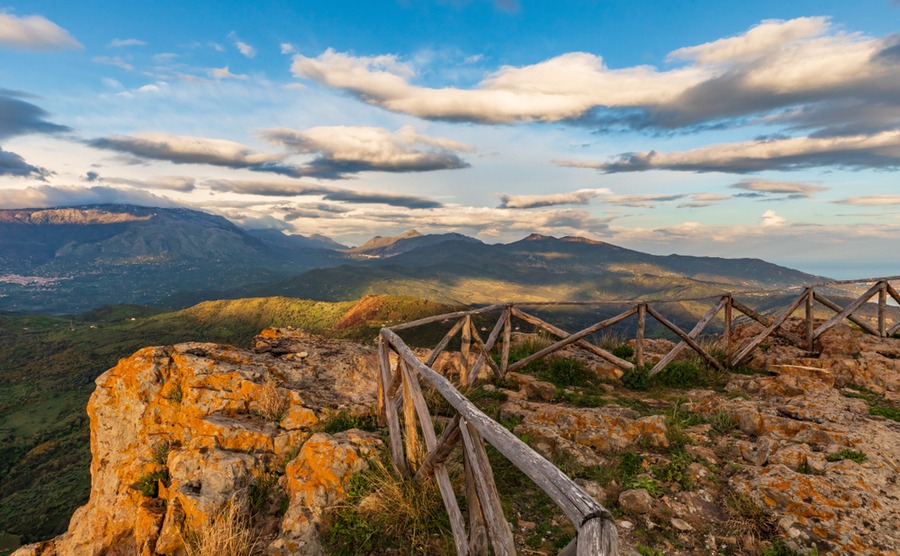
View of the Madonie mountain range and Madonie Regional Natural Park in Sicily
It has just been announced that protected areas in Italy have also been added to the International Union for Conservation of Nature’s (IUCN) Green List. These include Arcipelago Tosano National Park and Foreste Casentinesi, Monte Falterona and Campigna National Park. In addition, the Green List status of the country’s first National Park, Gran Paradiso, has also been renewed
Italy shows other countries how ‘eco-friendly’ is really done
Over 35 per cent of Italy is covered in trees (27 million acres) and there are 24 national parks. The country has plenty of sun and wind, so photovoltaic and wind farms are dotted across the country. Recycling is encouraged and towns have separated waste collection.
The use of bicycles and electric cars, especially in the larger cities, is greatly encouraged. Cycle routes and shared bicycle schemes are popping up all over the country. It’s easy to shop locally, with great streets markets and small family run stores. Even some of Italy’s fashion brands are using recycled materials in their clothing.
An eco-friendly home that is built to last and has beautiful architectural features, will be loved for generations to come. Plus, you can feel proud of the part you played in saving “Mother Earth”. To find out more about renovating in Italy see “Renovating in Italy. We did it, so can you!”














